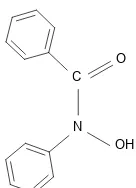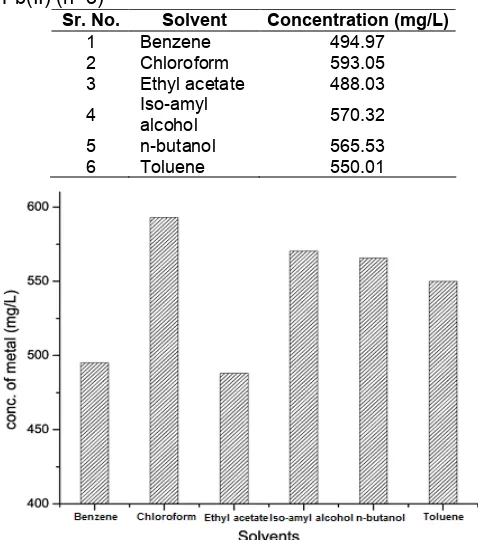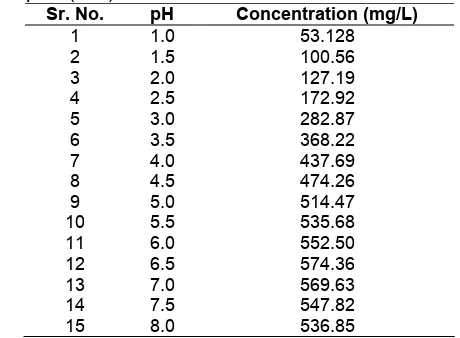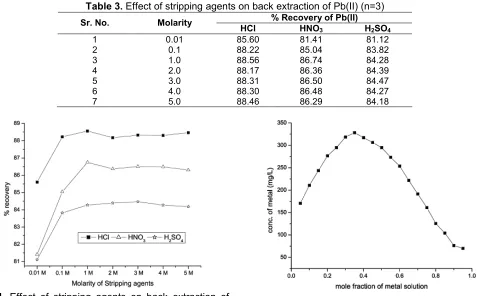FORMULA ESTABLISHMENT OF COLORLESS Pb(II) COMPLEX
WITH N-BENZOYL-N-PHENYL HYDROXYLAMINE (BPA)
USING ATOMIC ABSORPTION SPECTROSCOPY
Dhananjay B. Sarode
*, Sopan T. Ingle, and Sanjay B. Attarde
School of Environmental and Earth Sciences, North Maharashtra University,Post Box 80, Umavi Nagar, Jalgaon- 425 001, (M.S) India Received October 21, 2011; Accepted January 24, 2012
ABSTRACT
A new method for determination of stoichiometry of colorless complexes using atomic absorption spectrophotometric technique in continuous variation method and slope ratio method was described here. This method can be used in same manner as that of mole ratio method and slope ratio method. In this method atomic absorption spectroscopy was used instead of UV-Vis spectrophotometry. Atomic absorption spectrophotometric technique is superior to UV-Vis spectrophotometry as it can be applied to colorless soluble complexes. Pb(II) and n-benzoyl-n-phenyl hydroxylamine react to form colorless complex at pH 6.5, which can be easily determined by this method. It was found that Pb(II) forms 1:2 complex with n-benzoyl-n-phenyl hydroxylamine and is quantitatively extracted back to aqueous solution for AAS analysis.
Keywords: Stoichiometric ratio of complex ions; continuous variation method; slope ratio method; n-benzoyl-n-phenyl hydroxylamine; Pb(II)
ABSTRAK
Metode baru untuk penentuan stoikiometri kompleks tak berwarna menggunakan teknik spektrofotometri serapan atom dengan cara variasi kontinyu dan rasio slope (kemiringan) telah dilakukan. Metode ini dapat digunakan dengan cara yang sama seperti metode rasio mol dan metode rasio kemiringan. Dalam metode ini, spektroskopi serapan atom (AAS) digunakan sebagai pengganti UV-Vis spektrofotometri. AAS lebih unggul UV-Vis spektrofotometri karena dapat diterapkan untuk kompleks larutan tidak berwarna. Pb(II) dan n-benzoil-n-fenil hidroksilamin bereaksi membentuk kompleks tak berwarna pada pH 6,5, yang dapat dengan mudah ditentukan dengan metode ini. Ditemukan bahwa Pb(II) membentuk kompleks dengan n-benzoil-n-fenil hidroksilamin (1:2) dan secara kuantitatif diekstraksi kembali ke larutan air untuk analisis AAS.
Kata Kunci: rasio stoikiometri ion kompleks; metode variasi kontinu; metode rasio slope; n-benzoil-n-fenil hidroksilamin; Pb(II)
INTRODUCTION
Lead is the important and valuable elements from both industrial and environmental points of view. Release of Pb into environment is potentially harmful [1-2]. Due to increased demands of extraction and recovery of this metal, study of the composition of complexes formed by this metal is of great concern. The compound n-benzoyl-n-phenyl hydroxylamine (BPA) (CAS. No. 304-88-1) has been successfully employed as spectrophotometric, gravimetric, and extracting reagents [3]. It has been used as an analytical reagent for extraction, separation, spectrophotometric and gravimetric determination of many metal ions [4]. BPA is a well known weak acidic chelating agent used for the extraction and estimation of metal ions [5]. BPA has
been used in coprecipitation methods for the determination of trace metal ions [6]. The reagent has also been incorporated into methods involving extraction procedure. BPA has been used as a solvent extraction agent to separate platinum group elements (Pt, Pd, Ru and Ir) and Re from interfering elements (i.e., Zr, Mo, Hf, and W). [7]. BPA has been used as an organo-analytical reagent for the determination of trace metal ions [6] for tin [8] for vanadium [9] and for tantalum [10]. Use of this reagent in extraction and recovery of Pb(II) can be beneficial for industries and environmental laboratories.
C
N O
OH [17-20]. Spectrophotometric methods are useful for
determining the formulae and compositions of colored complexes [21]. All these methods use UV-Visible spectrophotometry which is strongly based on the absorbance measurements of the colored solutions. Though these methods are widely used from long period, these methods are applicable only when metal and ligand forms a colored complex. These methods do not give any idea about composition of colorless complexes formed between metal and ligand.
In 1963, Job’s method was used for the determination compositions of colorless complexes using the color forming auxiliary complexing agent. [22]. Voltammetric method [23] Amperometric method [24] and conductometric method [25] has been developed for the determination compositions of colorless complexes. In present study atomic absorption spectrophotometric technique in continuous variation method and slope ratio method was used which will be helpful to understand the reaction between metal and ligand which forms colorless complex. This method is useful for the determination of the formula and the composition of the colorless complex.
EXPERIMENTAL SECTION
Materials
All chemicals and reagents used in this research work were of analytical reagent grade supplied from Fischer Scientific, India. De-ionized water was used for the preparation of solutions and analysis throughout the research work.
Instrumentation
The concentration measurement of the metal ion was carried out with an atomic absorption spectrophotometer, AAS (Thermo Scientific, U.K. make, Solaar S series model). The pH measurements were done with an electronic pH meter (Elico LI 120), calibrated with standard buffer solutions.
Procedure
Formula establishment of colorless Pb(II) complex with n-benzoyl-n-phenyl hydroxylamine (BPA) using atomic absorption spectroscopy involves the two stage extraction. The structure of BPA [26] is shown in Fig.1. To achieve the maximum extraction of Pb(II) in the liquid -liquid extraction process, it is essential to optimize the various experimental conditions such as the effect of different solvents, pH of the solution and effect of stripping agents on percentage recovery.
Fig 1.Structure of n-benzoyl-n-phenyl hydroxylamine
Effect of Solvent
To check the effect of different solvents on extraction process six organic solvents were selected like benzene, chloroform, ethyl acetate, iso-amyl alcohol, n-butanol and toluene. 0.01 M BPA solution was prepared by dissolving the reagent in each organic solvent and diluted to 100 mL in volumetric flasks. A 0.01 M solutions of Pb(II) was prepared in de-ionized water using A.R. grade Pb (NO3)2 anhydrous. 10 mL metal solution was transferred to 60 mL separatory funnel followed by 10 mL of organic solvent containing BPA was added to it. The mixture was shaking at room temperature for 10 min. The organic phase was separated into another 60 mL separatory funnel. This organic phase was back extracted with 0.1 M HCl and the aqueous phase was separated. The concentration of back extracted metal was measured on AAS. The results were expressed as averages of triplicate analysis.
Effects of pH
To check the effect of pH on extraction efficiency the extraction was carried out using various pH conditions. This study was carried out between the pH ranges from 1 to 8. The buffer solutions used to adjust the pH were KCl/HCl buffer for pH 1 and 2; H3PO4/NaH2PO4 buffer for pH 3; CH3COOH/CH3COONH4 buffer for pH 4-6; KH2PO4/NaOH buffer for pH 6-8. The extraction was carried out as described above and the back extracted metal concentrations were measured on AAS. The results were expressed as averages of triplicate analysis.
Effect of stripping agent
The results were expressed as averages of triplicate analysis.
Continuous variation method
For finding the formula of a complex the solutions were prepared in such way that the sum of formal concentration of metal and ligand is the same while there ratio varies same as in continuous variation method [27]. pH of the Pb(II) solution was adjusted at pH 6.5. 0.01 M solution of n-benzoyl-n-phenyl hydroxylamine was prepared in chloroform. 0.5, 1.0, 1.5, 2.0, 2.5,……and 9.5 mL of 0.01 M metal solutions were pipetted in nineteen 10 mL volumetric flasks, volume was made up to 10 mL by de-ionized water. 9.5, 9.0, 8.5, 8.0, 7.5,……and 0.5 ml of 0.01 M ligand solutions were pipetted in another nineteen 10 mL volumetric flasks and volume was made up to 10 mL by chloroform. These solutions were transferred to nineteen 60 mL separating funnels in the series of 0.5:9.5, 1.0:9.0, 1.5:8.5,…….and 9.5:0.5 and the metal was extracted in organic phase. This organic phase containing metal complex was stripped out in 1 M HCl as an aqueous phase and it was separated from organic phase. The back extracted metal ion concentration was determined on AAS. The results were expressed as averages of triplicate analysis.
Slope ratio method
In this method two series of solutions were prepared same as in slope ratio method [28] using 0.01 M solutions each of metal and ligand. In the first series the ligand was in large excess (10 mL) and it was treated with 0.5, 1.0, 1.5, 2.0, 2.5, 3.0, 3.5, 4.0 and 4.5 mL of metal solutions. The volume of metal solution in each flask was made up to 10 mL with de-ionized water before addition of ligand. In second series the metal content was in large excess (10 mL) and it was treated with 0.5, 1.0, 1.5, 2.0, 2.5, 3.0, 3.5, 4.0 and 4.5 mL of ligand solutions. The volume of ligand solution in each flask was made up to 10 mL with chloroform before addition of metal solution. In both series organic phase containing metal complex was stripped out in 1 M HCl as an aqueous phase and it was separated from organic phase. The back extracted metal ion concentration was determined on AAS. The results were expressed as averages of triplicate analysis.
RESULT AND DISCUSSION
Effect of Solvent
For solvent extraction, metal complexes should be quantitatively distributed into organic phase from an aqueous phase. The metal complexes are extracted from an aqueous phase into an organic solvent, where the complexes can be stabilized. The solvent polarity can
Table 1. Effect of various solvents on extraction of Pb(II) (n=3)
Sr. No. Solvent Concentration (mg/L)
1 Benzene 494.97
2 Chloroform 593.05
3 Ethyl acetate 488.03
4 Iso-amylalcohol 570.32
5 n-butanol 565.53
6 Toluene 550.01
Fig 2. Effect of different solvents used for Pb(II) extraction
have a significant influence on extraction efficiency because a solvent can usually dissolve solute of a similar polarity [29].
The efficiency of several organic solvents should be compared for the best extraction of metal complexes. It would be expected that the introduction of electron-withdrawing substituent into the n-benzoyl group of the BPA would differ from BPA, such as in the acidity of the compounds, in the distribution behavior of compounds between aqueous and organic, and in solubilities in aqueous solution. Therefore, it would also be expected that the extraction behavior of metal ions with substituted reagents would differ from that of BPA. Pb(II) was extracted with six different organic solvents like benzene, chloroform, ethyl acetate, iso-amyl alcohol, n-butanol and toluene. Pb(II) forms colorless soluble complex with BPA. The results obtained while studying effect of solvents on the extraction are given in Table 1.
The concentration of Pb(II) extracted was plotted against various solvents. Fig. 2 shows the comparison between extracted concentrations obtained using various solvents.
Table 2. Effect of pH on the extraction of Pb(II)-BPA complex (n=3)
Sr. No. pH Concentration (mg/L)
1 1.0 53.128
15 8.0 536.85 Fig 3. Effect of pH on the extraction of Pb(II)-BPA
complex
nature of the solvent medium [30]. During the complexation, the ligand should be able to replace the solvent molecules as completely as possible in the first solvation shell of the cation, or the cation should be able to replace the solvent molecule with the ligand. Therefore, the variation of the solvent produces a significant change in the binding properties and selectivity of the ligand for a certain cation over the others [31]. Study shows all the six solvents used are able to extract the Pb(II) and form the complex. It was found that lowest amount of complex formation was observed in benzene and ethyl acetate. Medium level of complex formation was observed in Iso-amyl alcohol, n-butanol and toluene and the maximum amount of complex formation was found with chloroform. Chloroform is highly polar solvent as compare to other solvents used and polar solvents proved more efficient than non-polar solvents [29]. The extraction of Pb(II) was found to be quantitative when the chloroform was used as a solvent. Therefore it is concluded that chloroform was the most efficient solvent for the extraction of Pb(II) to form the maximum amount of complex with BPA.
Effects of pH
The complex formation of BPA with metal ion is dependent on the pH of the medium. BPA is proved to be efficient reagent in liquid–liquid extraction whose selectivity is determined which is strongly depends on the pH of the aqueous phase [32]. The most important parameter affecting the extraction is pH of the solution because the formation of the soluble metal complexes and their stabilities in aqueous solutions are strongly related to the pH of the medium. Therefore to check the effect of pH on extraction efficiency the extraction was carried out using various pH conditions. The results obtained for effect of pH are given in Table 2.
The concentration of Pb(II) extracted was plotted against the pH. Fig. 3 shows that the effects of pH change on the extraction efficiency. The formation of a stable chelating complex requires that the chelating agent of a Lewis base has a functional group. The group could donate its electron pair to metal ions. And it is an advantage for the agent if it has a negative charge [29]. As shown in Fig.1 BPA has a negative charge and hydroxyl group which can be ionized to form a stable complex with metal ion. In the acidic region 1-3 very less amount of complex was formed. Increase in the amount of complex formation was observed with the increasing pH. The maximum concentration of Pb(II) extracted was found at pH 6.5 it means that at this pH hydroxyl group was ionized and donated the electron pair to Pb(II) to form the stable complex. Pb(II) was extracted quantitatively between the pH ranges of 6-7. After the pH 7 then there was the decrease in the amount of complex formation. Therefore it can be concluded that pH 6.5 is the optimum pH condition for the extraction of Pb(II) from the Pb(II)-BPA complex. Increase or decrease in pH than this can cause decrease in extraction efficiency.
Effect of stripping agent
Table 3.Effect of stripping agents on back extraction of Pb(II) (n=3)
% Recovery of Pb(II)
Sr. No. Molarity
HCl HNO3 H2SO4
1 0.01 85.60 81.41 81.12
2 0.1 88.22 85.04 83.82
3 1.0 88.56 86.74 84.28
4 2.0 88.17 86.36 84.39
5 3.0 88.31 86.50 84.47
6 4.0 88.30 86.48 84.27
7 5.0 88.46 86.29 84.18
Fig 4. Effect of stripping agents on back extraction of
Pb(II) Fig 5.Continuous variation plot for Pb(II)-BPA complex
extraction of Pb(II) may affect the percentage recovery. The Pb(II) was stripped out from the organic phase of BPA with different molarities of acids such as HCl, HNO3 and H2SO4. The results obtained in this study are shown in Table 3.
The concentration of Pb(II) extracted was plotted against the molarities of stripping agent solution used for back extraction as shown in Fig. 5. It was found that change in acid molarity for the back extraction change the percentage recovery. H2SO4 was unable to recover high amount of the Pb(II) from the complex lowest recovery was found with it as compare to HCl and HNO3. 3 M H2SO4 can recover only 84.47% Pb(II) quantitatively. 1 M HNO3 can recover 86.74% of Pb(II). The maximum percentage recovery as compare to HNO3 and H2SO4 was found with 1 M HCl which is 88.56%. Maximum percentage recovery of Pb(II) from organic phase of BPA was observed with 1 M HCl therefore it can be concluded that 1 M HCl is used as a best stripping agent for the maximum recovery of the Pb(II) from the Pb(II)-BPA complex.
Continuous variation method
Method of continuous variation has been identified by Job [27] which is applicable to complex ions. The
formation of the many complex ions can be represented by the equation:
xM + yL MxLy
in which M is metallic ion and L is a ligand. Determination of x and y can be done by mixing solutions of M and L of the same molar concentrations but in varying proportions and the suitable property of the resulting solutions was measured [27]. This procedure causes the mole ratio of reactant to be varied across the set of mixture solutions. Job has measured the absorbance of the complex solution and plotted vs. the mole fraction of one of the reactants (M or L).
In the present study the reaction of Pb(II) with BPA was studied for its molar composition at pH 6.5. It was found that Pb(II)-BPA complex is a colorless complex. As it forms a colorless complex it was difficult to measure the absorbance of the solution. Therefore after the complex formation the metal entity was stripped out from organic phase in 1 M HCl as an aqueous phase and it was separated from organic phase. The back extracted metal concentration was measured by using atomic absorption spectroscopy. The results obtained for this method are given in Table 4.
Table 4.Data obtained by continuous variation method for Pb(II)-BPA complex (n=3)
Sr. No. mL of metal ion solution mL of BPA solution Mole fraction of metal Concentration of metal (mg/L)
1 0.5 9.5 0.05 170.54
2 1.0 9.0 0.10 210.59
3 1.5 8.5 0.15 243.61
4 2.0 8.0 0.20 276.47
5 2.5 7.5 0.25 294.89
6 3.0 7.0 0.30 318.31
7 3.5 6.5 0.35 328.19
8 4.0 6.0 0.40 317.13
9 4.5 5.5 0.45 306.34
10 5.0 5.0 0.50 294.92
11 5.5 4.5 0.55 273.11
12 6.0 4.0 0.60 253.56
13 6.5 3.5 0.65 221.76
14 7.0 3.0 0.70 191.30
15 7.5 2.5 0.75 161.04
16 8.0 2.0 0.80 125.40
17 8.5 1.5 0.85 104.08
18 9.0 1.0 0.90 76.25
19 9.5 0.5 0.95 69.97
Table 5.Data obtained by slope ratio method for Pb(II)-BPA complex (n=3)
Varying metal ion concentrations Varying ligand concentrations
mL of metal ion solution
mL of BPA solution
Concentration of metal (mg/L)
mL of metal ion solution
mL of BPA solution
Concentration of metal (mg/L)
0.5 10 44.12 10 0.5 20.80
1.0 10 82.56 10 1.0 47.07
1.5 10 152.30 10 1.5 81.70
2.0 10 223.01 10 2.0 129.44
2.5 10 271.08 10 2.5 141.38
3.0 10 343.65 10 3.0 180.89
3.5 10 369.43 10 3.5 232.25
4.0 10 398.86 10 4.0 267.30
4.5 10 405.25 10 4.5 287.61
Fig 6.Slope ratio for Pb(II)-BPA complex Fig 7.Structure of the Pb(II)-BPA complex
the mixture as shown in Fig. 5. For a 1:2 complex ML2, the absorbance will pass through maximum at mole fraction of metal f = 0.33 [27]. Experimentally the highest concentration value has been occurred at a mole fraction of f = 0.35. A mole fraction f = 0.35 of metal corresponds to a mole fraction f = 0.65 of ligand which reveals that the composition of complex is 1:2, means the formula of a complex is ML2for Pb(II)-BPA complex.
Slope ratio method
series the concentration of ligand L was varied in the presence of a constant excess amount of metal M [28].
Therefore after the complex formation between Pb(II) and BPA the metal entity was stripped out back from organic phase in 1 M HCl as an aqueous phase and it was separated from organic phase. The back extracted metal concentration was measured by using atomic absorption spectroscopy. The results obtained by this method are given in Table 5.
The plot of concentration of the Pb(II) solution extracted against the concentration of metal and ligand gives the straight line as shown in Fig. 6. The slope y/x of each line was calculated from the graph and the M:L was evaluated. The slope ratio value of 1:1.71 was obtained for M:L, which is approx equal to 1:2. This value also shows the 1:2 compositions, means the formula of a complex is ML2for the Pb(II)-BPA complex.
BPA reacts with Pb(II) to form water insoluble colorless complex. Complex formation takes place by replacement of hydroxylamino hydrogen by the metal ion with coordination of the carbonyl oxygen [36]. As the continuous variation method and slope ratio method shows the 1:2 (ML2) compositions, the structure of the Pb(II)-BPA complex can be drawn as shown in Fig.7.
CONCLUSION
Pb(II) forms maximum amount of complex with BPA when chloroform solution is used as a solvent at pH 6.5 which can be stripped out back from organic phase by 1 M HCl and recovered quantitatively. Continuous variation method and slope ratio method using UV-Vis spectrophotometry is not useful in case of colorless solutions, it limits only for colored solutions, but this method becomes useful if coupled with atomic absorption spectrophotometry for colorless complexes. By using atomic absorption spectrophotometric technique in continuous variation method and slope ratio method clear results can be obtained for elucidation of formula of the colorless complex. Pb(II) forms colorless complexes with n-benzoyl-n-phenyl hydroxylamine (BPA) at pH 6.5. Pb(II) and BPA reacts to form 1:2 complex, it means the formula of a complex is ML2 and is quantitatively extracted back to aqueous solution for AAS analysis.
REFERENCES
1. Desenfant, F., Veron, A.J., Camoin, G.F., and Nyberg, J., 2006,Coral. Reefs.,25, 3, 473–484. 2. Klee, R.J., and Graedel, T.E., 2004, Annu. Rev.
Environ. Resour.,29, 69–107.
3. Inoue, S., Zhang, Q., and Uto, M., 2004, Solvent Extr. Ion Exch.,22, 1, 121–133.
4. Yang, X.J., and Pin, C., 2002, Anal. Chim. Acta,
458, 375–386.
5. Dallali, N., Ghiasi, J., and Agrawal, Y.K., 2009,
Indian J. Chem. Technol.,16, 150–154.
6. Sacmaci, S., and Kartal, S., 2010,Microchim. Acta,
170, 1-2, 75–82.
7. Shinotsuka, K., and Suzuki, K., 2007, Anal. Chim. Acta, 603, 129–139.
8. Ryan, D.E., and Lutwick, G.D., 1953, Can. J. Chem.,31, 9–12.
9. Asadollahi, T., Dadfarnia, S., and Shabani, A.M.H., 2010,Talanta,82, 1, 208–212.
10. Moshier, R.W., and Schwarberg, J.E., 1957, Anal. Chem.,29, 947–951.
11. Getvoldsen, G.S., Elander, N., and Stone-Elander, S.A., 2002,Chem. Eur. J.,8, 10, 2255–2260. 12. Pivonka, D.E., and Empfield, J.R., 2004, Appl.
Spectrosc.,58, 1, 41–46.
13. Barnard, T.M., and Leadbeater, N.E., 2006,Chem. Commun.,3615–3616.
14. Leadbeater, N.E., and Smith, R.J., 2006,Org. Lett.,
8, 20, 4589–4591.
15. Leadbeater, N.E., Smith, R.J., and Barnard, T.M., 2007,Org. Biomol. Chem.,5, 822–825.
16. Leadbeater, N.E., and Smith, R.J., 2007, Org. Biomol. Chem.,5, 2770–2774.
17. Seleem, H.S., El-Inany, G.A., Mousa, M., and Hanafy, F.I., 2009, Spectrochim. Acta, Part A, 74, 4, 869–874.
18. Jani, G.R., Vyas, K.B., Nimavat, K.S., and Franco, J., 2009,Der Pharma Chemica,1, 2, 304–311. 19. Demirhan, N., and Elmali, F.T., 2003, Turk. J.
Chem.,27, 315–321.
20. Koricanac, Z., Jovanovic, T., Petkovic, J., and Minic, D., 2004,J. Serb. Chem. Soc., 69, 9, 485– 491.
21. Septhum, C., Rattanaphani, V., and Rattanaphani, S., 2007,Suranaree J. Sci. Technol.,14, 1, 91–97. 22. Mahadevan, N., Sathe, R.M., and Venkateswrlu,
Ch., 1963, J. Inorg. Nucl. Chem., 25, 8, 1005– 1010.
23. Ogura, K., Fukusima, Y., and Aomizu, I., 1980, J. Electroanal. Chem. Interfacial Electrochem., 107, 271–279.
24. Ogura, K., 1984, Electrochim. Acta, 29, 4, 527– 531.
25. El-Bindary, A.A., El-Sonbati, A.Z., El-Mosalamy, E.H., and El-Santawy, E.M., 2001, Spectrochim. Acta Part A, 57, 12, 2359–2365.
26. Xiong, C., Jiang, Z., and Hu, B., 2006,Anal. Chim. Acta,559, 1, 113–119.
27. Job, P., 1928,Ann. Chim.,9, 113–203.
29. In, G., Kim, Y., and Choi, J., 2008, Bull. Korean Chem. Soc.,29, 5, 969–973.
30. Rounaghi, G.H., Chamsaz, M., and Nezhadali, A., 2000, J. Inclusion Phenom. Macrocyclic Chem., 38, 1-4, 153–161.
31. Nezhadali, A., Hosseini, H.A., and Langara, P., 2007,e-J. Chem.,4, 4, 581–586.
32. Ali, A., Shahida, S., Khan, M.H., and Saeed, M.M., 2011,J. Radioanal. Nucl. Chem.,288, 3, 735–743.
33. Pawar, S.D., and Dhadke, P.M., 2003, J. Serb. Chem. Soc.,68, 7, 581–591.
34. Ghag, S.M., and Pawar, S.D., 2010, J. Serb. Chem. Soc.,75, 11, 1549–1557.
35. Talla, R.G., Gaikwad, S.U., and Pawar, S.D., 2010,
Indian J. Chem. Technol.,17, 436–440.




